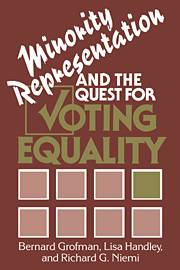Book contents
- Frontmatter
- Contents
- Acknowledgments
- List of Tables
- Introduction
- 1 The Right to Vote and the Right to Representation
- 2 The Evolution of a Vote Dilution Standard Through 1986
- 3 The Vote Dilution Standard in the Post-Gingles Era: Clarifications and Complications in the Lower Courts
- 4 Defining and Measuring Racially Polarized Voting and Other Elements of the Totality of the Circumstances
- 5 Vote Dilution in Single-Member Districts and Other Issues of the 1990s
- 6 The Voting Rights Act and the Realistic Politics of Second Best: An Optimistic Look to the Future
- Notes
- References
- Index of cases
- Index
5 - Vote Dilution in Single-Member Districts and Other Issues of the 1990s
Published online by Cambridge University Press: 18 March 2010
- Frontmatter
- Contents
- Acknowledgments
- List of Tables
- Introduction
- 1 The Right to Vote and the Right to Representation
- 2 The Evolution of a Vote Dilution Standard Through 1986
- 3 The Vote Dilution Standard in the Post-Gingles Era: Clarifications and Complications in the Lower Courts
- 4 Defining and Measuring Racially Polarized Voting and Other Elements of the Totality of the Circumstances
- 5 Vote Dilution in Single-Member Districts and Other Issues of the 1990s
- 6 The Voting Rights Act and the Realistic Politics of Second Best: An Optimistic Look to the Future
- Notes
- References
- Index of cases
- Index
Summary
Legal standards to determine when a single-member district plan constitutes a racial gerrymander in violation of the Voting Rights Act (or the U.S. Constitution) are not as well developed as are the standards for dilution involving multimember districts and at-large elections. This is in large part because there have been far fewer cases involving challenges to single-member district plans. Moreover, except for the legislative districts in New York whose redrawing was the subject of a challenge to the Justice Department's discretionary authority under Section 5 of the Voting Rights Act and for the congressional seats in the Dallas area that were redrawn by a federal district court in remedying a Fourteenth Amendment violation, no single-member district plan challenged as a racial gerrymander has been the subject of other than a per curiam opinion of the Supreme Court, and neither of these cases postdates Gingles. Indeed, since Gingles was decided in 1986, as of mid–1991 only a handful of Section 2 cases involving challenges to single-member districts had been decided, and only four of these had been reviewed at the appellate level.
Despite this lack of activity to date, single-member district issues and related matters will rise to the fore in the 1990s. For one thing, the number of challenges to at-large or multimember district systems is likely to fall, as a large number of the relevant jurisdictions have already been successfully challenged (see the state-by-state summaries in Davidson and Grofman, 1992), and many of the remaining jurisdictions are likely to adopt single-member districts rather than incur the costs of a voting rights lawsuit in which they are unlikely to prevail.
Information
- Type
- Chapter
- Information
- Minority Representation and the Quest for Voting Equality , pp. 109 - 128Publisher: Cambridge University PressPrint publication year: 1992
